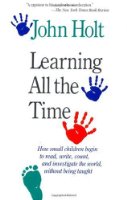The essence of John Holt’s insight into learning and small children is captured in Learning All The Time. This delightful book by the influential author of How Children Fail and How Children Learn shows how children learn to read, write, and count in their everyday life at home and how adults can respect and encourage this wonderful process. For human beings, he reminds us, learning is as natural as breathing. John Holt’s wit, his gentle wisdom, and his infectious love of little children bring joy to parent and teacher alike.
If John Holt had his way, today's primers would be replaced with the large-print edition of The New York Times, cursive handwriting would fade into disuse, and talking "cutesy-wootsy" to children would be considered a criminal act. This highly opinionated former teacher and original thinker spent the last half of his life challenging widely accepted classroom practices. The author of 10 books that concentrate on early child development and education, Holt is widely considered the father of the modern-day homeschooling movement because he grew to believe that schools stifle the learning process. In this, his final book--compiled by colleagues from drafts, letters, and magazine essays written by Holt before he died in 1985--he strings together his own observations and philosophies to show how young children can be encouraged to learn everything from reading and math to music and science.
Holt's thoughts carry the power of common sense. One of his pet peeves: the silly, nonsensical rules of phonics drilled into schoolchildren today. One of those adages, found on the walls of many an elementary school classroom, goes, "When two vowels go out walking, the first one does the talking." Holt points out that two pairs of vowels in the sentence violate the rule. This is not only confusing to some children, but simply "dumb," he complains. He dismisses picture books and primers, with their small, simple vocabularies. In their place, Holt urges parents to expose children to the Yellow Pages, warranties, letters, ticket stubs, and newspapers--the print trappings that adults rely upon for everyday life. Holt's call for context amid learning is delivered in a sensible, delightful writing style. He even includes several graphics and number games that can easily be used at home. Anyone who comes in contact with a small child would benefit from--and enjoy--reading these last words from a man who clearly adored and remained mesmerized by children and their inquisitive minds.








